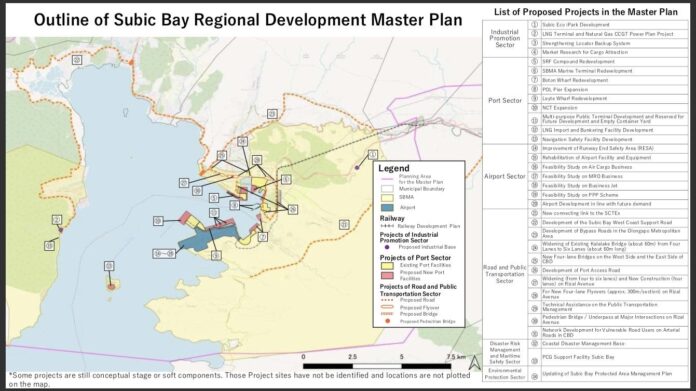-
Subic Bay development master plan finalized
-
The Subic Bay Regional Development Master Plan is a blueprint to maximizing economic development potentials of Subic Bay and its environs
-
The plan has 34 proposed projects related to the seaport, airport and road sectors
-
It aims to unlock Subic Bay’s full potentials, including its port capacity and connectivity with its hinterlands, with a view to helping decongest Metro Manila
-
Work on the master plan has been finalized with help from the Japan International Cooperation Agency
The Subic Bay Regional Development Master Plan has been finalized and endorsed by the Department of Finance (DOF).
The plan, which will serve as a blueprint to maximize the economic development potentials of Subic Bay and its surrounding areas, was finalized with the assistance of Japan International Cooperation Agency (JICA), the DOF said in a statement.
The plan has 34 proposed projects: nine for the seaport sector, seven for the air sector, 11 for road and public transportation, four for industrial promotions, two for disaster risk management and maritime safety, and one for environmental protection, according to material published on the Ministry of Foreign Affairs of Japan website.
The plan envisages Subic Bay region’s economic future and concrete development proposals from both public and private sectors, that would help unlock full potentials of Subic Bay, including its port capacity and connectivity with its hinterlands, with a view to helping efforts to decongest Metro Manila.
The joint effort of the Philippines and Japan to formulate a regional development master plan for Subic Bay began with a decision by the two countries’ leaders in November 2019 and the signing of a Memorandum of Cooperation to that effect in Hakone, Japan, in December 2019.
The finalized master plan was furnished by Japanese Ambassador to the Philippines Kazuhiko Koshikawa to Finance Secretary Carlos Dominguez III on April 7 in Manila. The completion of the master plan was also welcomed during Dominguez’s meeting on April 25 with Japanese Minister for Foreign Affairs Yoshimasa Hayashi.
Hayashi expressed hope that the publication of the master plan will prove conducive to the enhancement of regional connectivity and coast guard capabilities of the Philippines.
The Philippines and Japan signed the Memorandum of Cooperation on Subic Bay Regional Development in December 2019.
The Japanese side rendered technical support for the formulation of the master plan that maximizes the economic development potentials of Subic Bay by harmonizing logistics, industry and living functions, as well as existing assets and new investments.
The final plan covered possible development projects in the fields of road network for Olongapo’s Central Business District and Subic Bay West Coast, logistics terminals such as Alava Wharf, among others, and public utilities such as the Philippine Coast Guard’s new support facilities.
Earlier, Ronnie Yambao, Subic Bay Metropolitan Authority (SBMA) senior deputy administrator for operations, emphasized that Subic Bay Freeport is a multimodal logistics hub that can accommodate all types of commodities.
READ: Underused Subic airport eyes role as alternate hub to NAIA, Clark
He said the Freeport has a container terminal, 15 piers and wharves, an airport, and a big shipyard which will soon be managed by a new operator.
Once the Subic-Clark Railway is constructed and becomes operational, Subic Bay Freeport will be accessible via land, sea, air, and railway, Yambao said.
READ: China, PH ink $940M contract for Subic-Clark freight railway
The agency earlier said one of its priorities includes continuing and implementing expansion programs for port area development, enhancement of port facilities, and professionalization of seaport workforce.
Subic Bay International Airport is continuously being upgraded with potential for being a logistics hub, aircraft maintenance, repair and overhaul operations hub, and an alternate commercial gateway to help decongest Ninoy Aquino International Airport, the country’s main hub.





